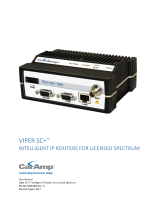
Prepared by Document
Jon-Olov Vatn Release Notes WeOS 5.10.0
Approved by Date Document No
Jonas Nylander March 26, 2021 224004-gad3be77
Alternatively, the DHCP server could be prepared to use the unit’s new MAC address, the base
MAC, when assigning the IP address. The base MAC of the unit can be found in several ways,
e.g., using the “show system-information” CLI command.
The rationale for shifting the default VLAN assignment mechanism relates to issue #18045: The MRM
switch is unreachable if ring port is ’lowest port’ on VLAN (RedFox/Lynx)”, see list of known issues
above.
The problem can occur between an MRM(B) and its neighbor(A) on the link with the blocked port. In
short, when A wish to communicate with B, it should send packets through port 1 towards D, which
in turn forwards them to C, and so on. But in some setups, A may be “tricked” to send packets to B in
the other direction, reaching B on its blocked port, where they will be dropped.
.-----. .-----. .-----. .-----.
| A | | B | | C | | D |
.---+1 2+--||+1 2+----+1 2+----+1 2+---.
| `-----' `-----' `-----' `-----' |
| MRC MRM MRC MRC |
| |
'----------------------------------------------'
(The example here is for MRP, but the same situation can occur for FRNT between the ’focal point’
and its neighbor ’member’ switch.) When this happens, the simplest workaround in WeOS 5.10 is to
assign VLAN MAC addresses on the MRM(B) to its base MAC. As mentioned above, this will be the
default behaviour from 5.11. More details are given below.
• VLAN interfaces (e.g., vlan1) inherit the MAC address from one of its associated ports; giving
precedence to the MAC of the ’lowest untagged port’, e.g., MAC address of eth1.
• eth1 port MAC is also used for some low level (MGMT) signalling protocols, e.g., as source
MAC in LLDP and MRP packets going out through eth1.
• ”WeOS 5 RedFox and Lynx” (Dagger platform) learn MAC address not only from regular
packets, but also from MGMT packets.
• In the example above, node A risk to learn the MAC of B’s interface vlan1 from the wrong
direction (from MGMT packets coming from B’s port eth1), thus A will be unable to reach B
on vlan1. Changing the MAC of B’s vlan1 to B’s base-MAC will remedy the problem.
4.3 #18163: Work-around for OSPF NSSAs convergence issue
When using OSPF Not-So-Stubby Areas (NSSAs), failover when a router goes down may take a lot
longer time than expected. There are two possible work-arounds until this bug is fixed:
• Alternative 1: Let each router get an address on its loopback interface, and include them in the
OSPF area, e.g., use OSPF setting “network 192.168.1.5/32 area 1” for a router in (NSSA) area
16 Copyright © 2021 Westermo Network Technologies AB























